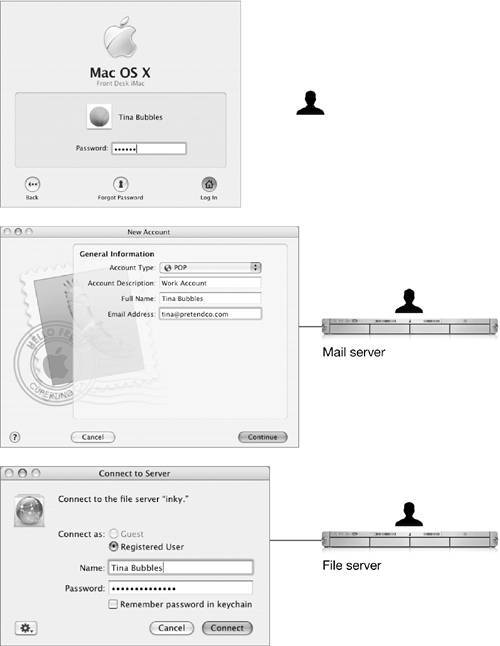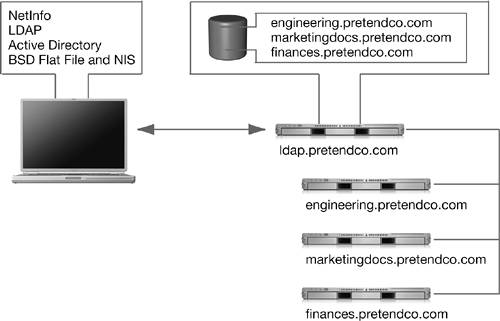Managing Multiple User Accounts
Many processes on Mac OS X require user account
information. Applications often ask for your identity and for a
means of authenticating that identity. The Finder needs to
translate user and group IDs to user and group names when
displaying file information. The identification information and the
authentication information (or methods) must be stored in a way
that makes it easy for applications to access.
In a networked environment, a user will
regularly access different servers, including servers for mail and
file sharing. For each of these servers, the user will also need to
provide a user name and password to gain access. In a corporate
environment, a user can quickly become overwhelmed with having to
track a different user name and password for each server. It is
much simpler for the user if the account information is also stored
in a way that it could be shared with servers.

Instead of each application or service storing
its own copy of user account information, Mac OS X uses directory
services to allow different processes to access a common set of
user account information. Directory services is a database service
that keeps track of the resources that are available to the users
of that database. In addition to providing service discovery, Open
Directory also provides directory services for Mac OS X.
Using Local User Accounts
Each Mac OS X computer has a database that
contains records for the local user accounts, such as the main
administrator account. When a process such as the login window
needs to access account information, it calls Open Directory, which
is responsible for retrieving the data from the local directory
service database. Because the different applications all use Open
Directory, they all have access to the same user account
information.
NOTE
Only user account information that is needed by
multiple processes is stored using Open Directory. User data that
is specific to an application, such as preferences, is still
managed by the application.
You do not need to do any configuration for
local directory services. Open Directory is preconfigured to store
local directory information using the NetInfo protocol. If you use
Directory Access to turn off NetInfo, you are only turning off
access to networked NetInfo directories; NetInfo will still be used
for local directory service data.
Using Network User Accounts
Because processes such as loginwindow don't
access the directory service database directly, a database doesn't
have to be stored on the local computer. With the proper
configuration, Open Directory can retrieve user records from a
network database in addition to those in the local database.

The advantage of network user accounts is that a
user in your network can log in to any computer on the network
using the same user name and password and, if used in conjunction
with network home folders, the user environment will look the same
on each computer. A user is no longer tied to a single computer,
but can log in from any computer that has access to the networked
database.
There are some things to keep in mind when using
networked user accounts. Networked user accounts used to require
constant access to the directory server where the user account
information was stored. To help manage accounts on computers that
are not always connected to the network, such as portable
computers, Mac OS X Server allows you to create mobile user
accounts. A mobile user account is a Mac OS X Server user account
that resides in a shared domain but is copied to the local
computer. This allows a user of a portable computer to log in using
a network account even when the computer is not connected to a
network.
There are a number of
ways to implement a networked directory service, but the industry
has mostly settled on Lightweight Directory Access Protocol (LDAP).
Closely related to LDAP is Microsoft's Active Directory. Active
Directory is based on LDAP, with some additional extensions that
are specific to Microsoft clients.
Setting up a networked directory service is a
job for the server administrator (and it is covered in the Mac OS X
Server course). You will learn how to set up Mac OS X to connect to
the directory services that you are most likely to encounter.
Sharing User Accounts with Directory
Services
Another advantage of storing user accounts on a
directory server is that multiple servers can access the directory
server's user accounts for authentication. Just as a directory
server allows a user to access the same user account on different
computers, sharing the user account with different servers allows
the user to access different services using the same user name and
password.
Multiple user accounts become an issue when a
number of systems use their own private user information to
authenticate users. When you check your mail, the mail server
doesn't know what user name and password you used to log in. The
login window checks your user name and password against its local
users list. The mail server has its own user list for
authentication. The login name and password for one service isn't
necessarily related to the login name and password for another
service.
One way to approach this problem is to make one
list of users available to all of these different systems. If the
login window, the email server, and the AFP server all look to the
same list of users, they can all accept the same user name and
password. If your password is changed on that master list, all of
those services will recognize the change at once and use your new
password.

Using Static Directory Discovery
A directory server can provide more than just
user account information. It can also provide a list of available
services.
Earlier you learned that Mac OS X uses dynamic
service discovery to scan the network and locate available
services. Mac OS X can also query a directory server for a list of
services that the server knows about. This is called static service
discovery because the server has to be explicitly queried to show
any changes to it. Each time a service is added to
the network, the administrator has to manually edit the static list
of services.


|